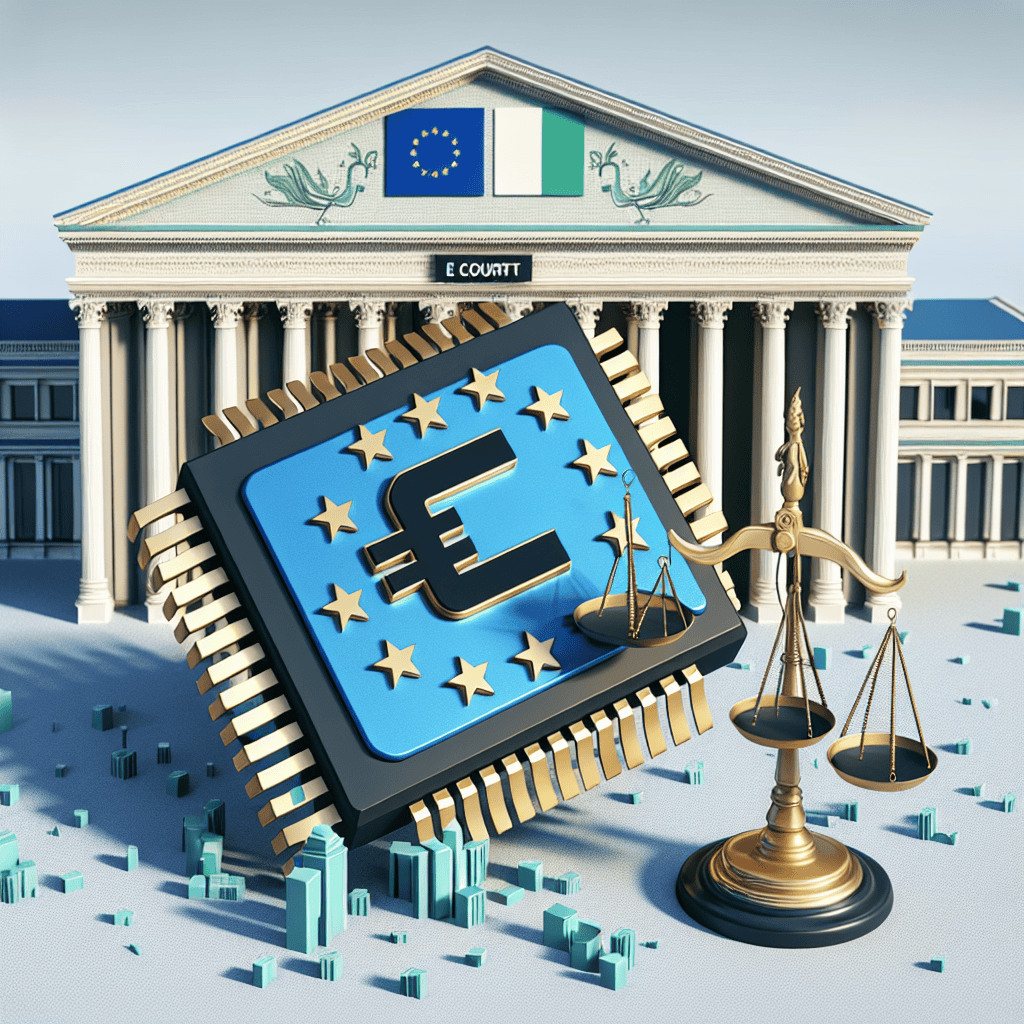“Intel Triumphs: Europe’s Top Court Clears Path in Antitrust Victory”
Introduction
In a landmark decision, Intel emerged victorious in a protracted antitrust battle as Europe’s highest court ruled in their favor, overturning a previous decision that had imposed a hefty fine on the tech giant. The case, which has been closely watched by industry experts and legal analysts, centered around allegations that Intel had engaged in anti-competitive practices to maintain its dominance in the semiconductor market. The European Court of Justice’s ruling not only absolves Intel of the charges but also sets a significant precedent for how antitrust laws are interpreted and enforced within the European Union. This outcome is expected to have far-reaching implications for the tech industry, potentially reshaping competitive strategies and regulatory approaches in the region.
Intel’s Legal Victory: A Landmark Antitrust Case in Europe
In a significant legal development, Intel Corporation has emerged victorious in a long-standing antitrust case, as Europe’s top court ruled in their favor. This landmark decision marks a pivotal moment in the realm of competition law within the European Union, setting a precedent for how antitrust cases may be approached in the future. The case, which has spanned over a decade, revolved around allegations that Intel had engaged in anti-competitive practices to maintain its dominance in the microprocessor market. Specifically, the European Commission had accused Intel of offering rebates to computer manufacturers, such as Dell and Hewlett-Packard, on the condition that they primarily use Intel’s chips, thereby stifling competition from rival Advanced Micro Devices (AMD).
The European Commission’s initial ruling in 2009 imposed a hefty fine of €1.06 billion on Intel, marking one of the largest penalties ever levied by the Commission for antitrust violations. However, Intel contested the decision, arguing that the Commission had failed to adequately demonstrate that the rebates had an anti-competitive effect on the market. This contention led to a protracted legal battle, culminating in the recent ruling by the Court of Justice of the European Union (CJEU).
In its judgment, the CJEU found that the European Commission had not sufficiently proven that Intel’s rebate scheme had restricted competition. The court emphasized the need for a thorough economic analysis to establish the actual impact of such practices on market competition. This ruling underscores the importance of a rigorous evidentiary standard in antitrust cases, highlighting that mere allegations of anti-competitive behavior are insufficient without concrete proof of their detrimental effects on the market.
Moreover, the court’s decision reflects a broader shift in the EU’s approach to antitrust enforcement, aligning it more closely with the economic-based analysis favored in other jurisdictions, such as the United States. This alignment may signal a move towards a more nuanced understanding of market dynamics, where the focus is on the actual harm to consumers and competition rather than solely on the conduct of dominant firms.
The implications of this ruling extend beyond Intel and the microprocessor industry, potentially influencing how future antitrust cases are prosecuted and defended within the EU. Companies operating in Europe may now find themselves subject to a more stringent evidentiary burden when facing antitrust allegations, necessitating a comprehensive demonstration of the competitive harm caused by their practices.
Furthermore, this decision may encourage firms to reassess their compliance strategies, ensuring that their business practices can withstand the scrutiny of a detailed economic analysis. For regulators, the ruling serves as a reminder of the importance of building robust cases supported by empirical evidence, which may lead to more meticulous investigations and a greater reliance on economic expertise.
In conclusion, Intel’s legal victory in this landmark antitrust case represents a turning point in European competition law. By emphasizing the necessity of a detailed economic assessment, the CJEU has set a new standard for evaluating anti-competitive practices, one that prioritizes the actual impact on market competition. As this ruling reverberates through the legal and business communities, it is likely to shape the future landscape of antitrust enforcement in Europe, fostering a more balanced and evidence-based approach to maintaining fair competition.
The Implications of Intel’s Antitrust Win for the Tech Industry
In a landmark decision, Europe’s top court has ruled in favor of Intel, marking a significant victory for the tech giant in a long-standing antitrust case. This ruling not only absolves Intel of previous allegations but also sets a precedent that could reshape the landscape of antitrust enforcement within the technology sector. The case, which has been closely watched by industry leaders and legal experts alike, underscores the complexities of regulating competition in a rapidly evolving market.
The European Court of Justice’s decision to overturn the previous ruling against Intel highlights the challenges regulators face in proving anticompetitive behavior in the tech industry. Initially, Intel was accused of abusing its dominant market position by offering rebates to computer manufacturers, allegedly to stifle competition from its main rival, AMD. However, the court found that the European Commission had not sufficiently demonstrated that these rebates had an anticompetitive effect. This outcome suggests that future antitrust cases may require more rigorous economic analysis and evidence to substantiate claims of market abuse.
Moreover, the ruling could have far-reaching implications for how antitrust laws are applied to other tech companies. As the industry continues to grow and diversify, with new players constantly emerging, the need for clear and consistent regulatory frameworks becomes increasingly important. This decision may prompt regulators to reassess their strategies and methodologies when investigating potential antitrust violations, ensuring that they are equipped to address the unique challenges posed by the digital economy.
In addition to influencing regulatory approaches, Intel’s victory may also embolden other tech companies facing similar scrutiny. The decision could encourage firms to challenge antitrust allegations more vigorously, knowing that the burden of proof lies heavily on the regulators. This shift in dynamics might lead to more protracted legal battles, as companies seek to defend their business practices and market strategies. Consequently, this could result in a more cautious approach from regulators, who may need to balance the enforcement of competition laws with the risk of costly and time-consuming litigation.
Furthermore, the ruling may impact the competitive strategies of tech companies, particularly in how they structure their pricing and rebate schemes. With the court emphasizing the need for concrete evidence of anticompetitive effects, companies might feel more confident in employing aggressive pricing tactics, provided they can demonstrate that such strategies do not harm competition. This could lead to increased innovation and consumer benefits, as firms strive to offer better products and services at competitive prices.
However, it is essential to consider the potential downsides of this decision. Critics argue that the ruling could weaken antitrust enforcement, allowing dominant players to engage in practices that may ultimately harm consumers and stifle innovation. As such, it is crucial for regulators to strike a delicate balance between fostering competition and ensuring that market leaders do not exploit their positions to the detriment of the industry as a whole.
In conclusion, Intel’s antitrust win represents a pivotal moment for the tech industry, with significant implications for regulatory practices, corporate strategies, and market dynamics. As the sector continues to evolve, it will be vital for all stakeholders to navigate these changes thoughtfully, ensuring that competition remains robust and that innovation continues to thrive. The outcome of this case serves as a reminder of the complexities inherent in regulating a fast-paced and ever-changing industry, highlighting the need for ongoing dialogue and collaboration between regulators, companies, and consumers.
How Intel’s Court Triumph Could Reshape European Competition Law
In a landmark decision, Europe’s top court has ruled in favor of Intel, marking a significant victory for the tech giant in a long-standing antitrust case. This ruling not only absolves Intel of previous allegations but also sets a precedent that could reshape the landscape of European competition law. The case, which has been closely watched by industry experts and legal scholars alike, centers around accusations that Intel engaged in anti-competitive practices by offering rebates to computer manufacturers, thereby squeezing out competitors. The European Commission had initially fined Intel a staggering €1.06 billion in 2009, asserting that these rebates were designed to undermine competition, particularly targeting rival Advanced Micro Devices (AMD).
However, the recent ruling by the European Court of Justice (ECJ) overturns this decision, emphasizing the need for a more nuanced approach in assessing the competitive impact of such rebates. The court highlighted that the Commission failed to adequately demonstrate that Intel’s practices had an actual detrimental effect on competition. This decision underscores the importance of a thorough economic analysis in antitrust cases, suggesting that mere assumptions of anti-competitive behavior are insufficient without concrete evidence of harm to the market.
The implications of this ruling are profound, as it challenges the traditional framework used by European regulators in evaluating anti-competitive conduct. By prioritizing economic evidence over presumptive assessments, the court has signaled a shift towards a more evidence-based approach in antitrust enforcement. This could lead to a reevaluation of existing cases and influence future investigations, potentially making it more challenging for regulators to prove anti-competitive behavior without substantial economic analysis.
Moreover, this decision may encourage companies to adopt more aggressive competitive strategies, knowing that the burden of proof lies heavily on regulators to demonstrate actual market harm. While this could foster innovation and drive down prices, it also raises concerns about the potential for increased market dominance by large corporations, which could stifle competition in the long run. Therefore, the ruling presents a delicate balance between promoting competitive practices and safeguarding against monopolistic behavior.
In addition to its impact on competition law, the Intel case also highlights the evolving relationship between European institutions and multinational corporations. As global markets become increasingly interconnected, the need for a coherent and consistent regulatory framework becomes paramount. This ruling may prompt European regulators to refine their approach, ensuring that it aligns with the complexities of modern business practices while maintaining fair competition.
Furthermore, the decision could influence other jurisdictions, as countries around the world grapple with similar antitrust challenges in the tech industry. By setting a precedent for a more rigorous analysis of competitive effects, the ECJ’s ruling may inspire a reevaluation of antitrust policies globally, encouraging a more balanced approach that considers both the benefits and potential drawbacks of aggressive competitive strategies.
In conclusion, Intel’s triumph in this antitrust case represents a pivotal moment in European competition law. The ruling not only vindicates Intel but also paves the way for a more evidence-based approach in assessing anti-competitive behavior. As regulators and companies navigate this new landscape, the challenge will be to strike a balance that fosters innovation while ensuring a level playing field for all market participants. This decision will undoubtedly shape the future of competition law in Europe and beyond, as stakeholders adapt to the evolving dynamics of the global marketplace.
Analyzing the Impact of Intel’s Antitrust Case on Global Markets

The recent ruling by Europe’s top court in favor of Intel in a long-standing antitrust case marks a significant moment in the global technology market. This decision, which overturns a previous ruling by the European Commission, has far-reaching implications for both the semiconductor industry and the broader landscape of antitrust enforcement. As we delve into the impact of this case, it is essential to understand the context and the potential consequences for global markets.
The case against Intel dates back to 2009 when the European Commission fined the company €1.06 billion for allegedly abusing its dominant position in the market for x86 central processing units (CPUs). The Commission argued that Intel had engaged in anti-competitive practices by offering rebates to computer manufacturers that favored its products over those of its competitors, particularly Advanced Micro Devices (AMD). This decision was initially upheld by the General Court of the European Union in 2014, reinforcing the Commission’s stance on maintaining competitive markets.
However, the recent ruling by the European Court of Justice (ECJ) has shifted the narrative. The ECJ found that the General Court had failed to properly assess Intel’s arguments regarding the potential effects of its rebate scheme on competition. By emphasizing the need for a thorough economic analysis, the ECJ’s decision underscores the importance of considering the actual impact of business practices on market competition rather than relying solely on their form. This nuanced approach to antitrust enforcement could influence future cases, prompting regulators to adopt more comprehensive assessments of competitive harm.
The implications of this ruling extend beyond Intel and the semiconductor industry. For multinational corporations operating in various sectors, the decision highlights the evolving nature of antitrust enforcement and the necessity of adapting to changing legal standards. Companies may now feel emboldened to challenge regulatory decisions, knowing that courts are willing to scrutinize the economic rationale behind antitrust rulings. This could lead to a more dynamic legal environment where businesses and regulators engage in more rigorous debates over the competitive effects of corporate strategies.
Moreover, the ruling may impact the European Commission’s approach to antitrust enforcement. As one of the most influential regulatory bodies globally, the Commission’s decisions often set precedents for other jurisdictions. The ECJ’s emphasis on economic analysis could prompt the Commission to refine its methodologies, potentially leading to more precise and economically grounded assessments of market behavior. This shift could enhance the credibility of antitrust enforcement, ensuring that interventions are justified by tangible competitive harm rather than theoretical concerns.
On a broader scale, the decision may influence global markets by affecting investor perceptions and corporate strategies. For Intel, the ruling provides a significant boost, potentially enhancing its competitive position and investor confidence. The company’s ability to navigate complex legal challenges successfully may reassure stakeholders and bolster its market standing. Conversely, competitors like AMD may need to reassess their strategies in light of Intel’s legal victory, potentially leading to shifts in market dynamics and innovation strategies.
In conclusion, the European Court of Justice’s ruling in favor of Intel in the antitrust case represents a pivotal moment with wide-ranging implications for global markets. By emphasizing the importance of economic analysis in antitrust enforcement, the decision may reshape regulatory approaches and influence corporate strategies across industries. As businesses and regulators adapt to this evolving landscape, the case serves as a reminder of the intricate interplay between law, economics, and competition in the global marketplace.
Intel’s Legal Strategy: Key Factors Behind Their Antitrust Success
In a landmark decision, Intel has emerged victorious in a protracted antitrust battle, as Europe’s top court ruled in their favor. This outcome marks a significant turning point in the realm of competition law, particularly within the technology sector. The case, which has spanned over a decade, centered on allegations that Intel had engaged in anti-competitive practices by offering rebates to computer manufacturers, thereby undermining its rival, Advanced Micro Devices (AMD). The European Commission had initially fined Intel a staggering €1.06 billion in 2009, asserting that these rebates were intended to stifle competition. However, Intel’s legal strategy, characterized by meticulous planning and a robust defense, ultimately led to their success in overturning this decision.
One of the key factors behind Intel’s antitrust success was their unwavering commitment to challenging the European Commission’s findings. From the outset, Intel maintained that their rebate schemes were not anti-competitive but rather a legitimate business practice aimed at fostering customer loyalty. This steadfast position was bolstered by a comprehensive legal strategy that involved a detailed examination of the economic impact of their practices. By presenting compelling economic evidence, Intel was able to demonstrate that their rebates did not harm competition but instead benefited consumers by lowering prices and enhancing product offerings.
Moreover, Intel’s legal team adeptly navigated the complexities of European competition law, which played a crucial role in their eventual triumph. They meticulously dissected the Commission’s arguments, highlighting inconsistencies and gaps in the evidence presented against them. This approach was instrumental in persuading the court to scrutinize the Commission’s analysis more closely. By emphasizing the need for a thorough examination of the actual effects of Intel’s practices on the market, the company successfully shifted the focus from theoretical assumptions to empirical evidence.
In addition to their legal acumen, Intel’s strategic use of expert testimony proved to be a decisive factor in their favor. The company enlisted the support of renowned economists and industry experts who provided authoritative insights into the competitive dynamics of the semiconductor market. These experts were able to articulate the complexities of the industry and elucidate how Intel’s actions were consistent with competitive behavior. Their testimony not only reinforced Intel’s arguments but also cast doubt on the Commission’s interpretation of the market dynamics.
Furthermore, Intel’s persistence in pursuing justice through multiple legal avenues underscored their determination to clear their name. After the initial ruling by the General Court in 2014, which upheld the Commission’s decision, Intel did not relent. Instead, they appealed to the European Court of Justice, which ultimately led to a reassessment of the case. This relentless pursuit of legal recourse demonstrated Intel’s confidence in their position and their commitment to upholding their reputation.
In conclusion, Intel’s antitrust success can be attributed to a combination of factors, including their steadfast defense, strategic legal maneuvers, and effective use of expert testimony. By challenging the European Commission’s findings with compelling economic evidence and highlighting the need for a nuanced understanding of market dynamics, Intel was able to secure a favorable ruling. This case not only underscores the importance of a robust legal strategy in antitrust disputes but also sets a precedent for future cases in the technology sector. As Intel celebrates this victory, it serves as a reminder of the intricate interplay between competition law and business practices in an ever-evolving global market.
The Future of Antitrust Regulations in Europe Post-Intel Ruling
The recent ruling by Europe’s top court in favor of Intel marks a significant turning point in the landscape of antitrust regulations within the European Union. This decision, which overturned a previous judgment against the tech giant, has sparked a renewed debate on the future of antitrust enforcement and its implications for both businesses and regulators. As the dust settles, it is crucial to examine the potential ramifications of this ruling and how it might shape the regulatory environment in Europe moving forward.
To begin with, the court’s decision to side with Intel underscores the complexities involved in antitrust cases, particularly those concerning large multinational corporations. The original case, which accused Intel of engaging in anti-competitive practices by offering rebates to computer manufacturers, was emblematic of the challenges regulators face in proving harm to competition. The court’s ruling highlighted the necessity for a more nuanced approach, emphasizing the importance of considering economic context and the actual impact on market dynamics. This shift in perspective could lead to a more balanced framework that takes into account both the need to foster competition and the realities of operating in a globalized economy.
Moreover, the Intel ruling may prompt a reevaluation of existing antitrust policies and enforcement strategies within the European Union. As regulators grapple with the implications of this decision, there is likely to be an increased focus on refining the criteria used to assess anti-competitive behavior. This could involve developing more sophisticated economic models and analytical tools to better understand the effects of corporate conduct on market competition. In turn, this may lead to more targeted and effective enforcement actions that are better aligned with the complexities of modern markets.
In addition to influencing regulatory practices, the Intel case could also have broader implications for businesses operating within the European Union. Companies may find themselves navigating a more uncertain regulatory environment as authorities work to adapt their approaches in light of the court’s ruling. This could necessitate a reevaluation of business strategies, particularly for firms in highly competitive industries where antitrust scrutiny is more prevalent. As a result, businesses may need to invest in compliance programs and legal expertise to ensure they remain on the right side of evolving regulations.
Furthermore, the Intel ruling may serve as a catalyst for discussions on the harmonization of antitrust regulations across different jurisdictions. As global markets become increasingly interconnected, there is a growing need for consistency in regulatory approaches to prevent conflicts and ensure fair competition. The European Union, with its diverse member states, is uniquely positioned to lead these efforts by fostering dialogue and collaboration among national authorities. By working towards a more unified regulatory framework, the EU can enhance its ability to address anti-competitive practices effectively while providing greater clarity and predictability for businesses.
In conclusion, the Intel antitrust ruling represents a pivotal moment for the future of antitrust regulations in Europe. As regulators and businesses alike adjust to the implications of this decision, there is an opportunity to reshape the regulatory landscape in a way that balances the need for competition with the realities of a globalized economy. By embracing a more nuanced and harmonized approach, the European Union can strengthen its position as a leader in antitrust enforcement, ensuring that markets remain competitive and innovative for years to come.
Lessons Learned from Intel’s Antitrust Case: A Guide for Tech Companies
In a landmark decision, Europe’s top court recently ruled in favor of Intel, marking a significant victory for the tech giant in a long-standing antitrust case. This ruling not only underscores the complexities of antitrust regulations but also offers valuable lessons for tech companies navigating the intricate landscape of competition law. As the digital economy continues to expand, understanding the implications of this case becomes crucial for businesses aiming to thrive in a competitive environment.
The case against Intel, which dates back to 2009, revolved around allegations that the company had engaged in anti-competitive practices by offering rebates to computer manufacturers, thereby hindering competitors. Initially, the European Commission imposed a hefty fine on Intel, asserting that these rebates were designed to exclude rivals from the market. However, the recent ruling by the European Court of Justice (ECJ) overturned this decision, emphasizing the need for a more nuanced analysis of market effects rather than relying solely on the form of the conduct in question.
One of the key lessons from this case is the importance of a thorough economic analysis in antitrust investigations. The ECJ highlighted that authorities must consider the actual or potential effects of a company’s conduct on competition, rather than presuming harm based on the nature of the conduct alone. This shift towards an effects-based approach signals a more rigorous standard for proving anti-competitive behavior, which could influence future antitrust cases across various sectors. For tech companies, this underscores the necessity of demonstrating how their business practices impact market dynamics, thereby ensuring compliance with competition laws.
Moreover, the Intel case illustrates the significance of legal strategy and perseverance in antitrust disputes. Over the years, Intel consistently challenged the European Commission’s findings, ultimately leading to a favorable outcome. This persistence highlights the importance of a robust legal defense and the willingness to engage in prolonged litigation if necessary. Tech companies facing similar challenges should be prepared to invest in comprehensive legal strategies, including the use of expert economic testimony, to effectively counter allegations of anti-competitive conduct.
Additionally, the ruling serves as a reminder of the evolving nature of antitrust regulations in the digital age. As technology continues to reshape markets, regulatory bodies are increasingly tasked with adapting traditional competition frameworks to address new challenges. This dynamic environment necessitates that tech companies remain vigilant and proactive in understanding regulatory trends and potential implications for their business models. By staying informed and engaging with regulators, companies can better anticipate and mitigate potential antitrust risks.
Furthermore, the Intel case underscores the importance of transparency and communication with regulatory authorities. Throughout the proceedings, Intel maintained open lines of communication with the European Commission, providing detailed information and cooperating with investigations. This approach not only facilitated a more informed assessment of the case but also demonstrated Intel’s commitment to compliance. For tech companies, fostering a cooperative relationship with regulators can be instrumental in navigating complex antitrust issues and achieving favorable outcomes.
In conclusion, the Intel antitrust case offers a wealth of insights for tech companies operating in an increasingly competitive and regulated environment. By emphasizing the importance of economic analysis, legal strategy, adaptability to regulatory changes, and transparent communication, this case provides a valuable guide for businesses seeking to navigate the challenges of antitrust law. As the digital economy continues to evolve, these lessons will remain pertinent for companies striving to maintain a competitive edge while adhering to the principles of fair competition.
Q&A
1. **What was the case about?**
The case involved antitrust charges against Intel, where the European Commission accused the company of abusing its dominant market position to stifle competition.
2. **Who brought the charges against Intel?**
The charges were brought by the European Commission, which is the executive branch of the European Union responsible for enforcing competition law.
3. **What was the original ruling?**
The European Commission originally ruled against Intel in 2009, imposing a fine of €1.06 billion for antitrust violations.
4. **What was the outcome of the appeal?**
Europe’s top court, the European Court of Justice, ruled in favor of Intel, overturning the previous decision and annulling the fine.
5. **What was the main reason for the court’s decision?**
The court found that the European Commission had not sufficiently proven that Intel’s practices had an anti-competitive effect on the market.
6. **What impact does this ruling have on Intel?**
The ruling is a significant legal victory for Intel, as it removes the financial penalty and clears the company of antitrust violations in this case.
7. **What are the broader implications of this ruling?**
The decision could impact how future antitrust cases are assessed in Europe, potentially requiring more rigorous economic analysis to prove anti-competitive effects.
Conclusion
The European Union’s top court ruling in favor of Intel in the antitrust case marks a significant victory for the company, potentially reshaping the landscape of antitrust enforcement in the tech industry. This decision overturns previous findings that Intel had engaged in anti-competitive practices by offering rebates to computer manufacturers, which were deemed to harm competition. The ruling underscores the importance of rigorous economic analysis in antitrust cases and may influence how future cases are assessed, emphasizing the need for clear evidence of consumer harm. This outcome not only alleviates a substantial financial burden for Intel but also sets a precedent that could impact how similar cases are approached in the future, potentially leading to a more nuanced interpretation of competitive practices in the technology sector.





